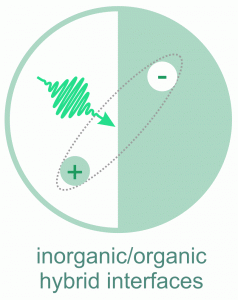 |
The combination of inorganic and organic semiconductors promises hybrid functionality for optoelectronic and light-harvesting applications. Any functionality of such inorganic/organic hybrid system is governed by the electronic levels and resonances at the interface. These determine the efficiency of charge and energy transfer processes, which occur on ultrafast timescales (femto- to picoseconds) and compete with relaxation channels as polaron formation, decay to dark (triplet) states, or trapping at defect sites. Also the electronic structure of the inorganic semiconductor surface is vital for charge and energy transfer processes. Effects like surface band bending and surface photovoltage shifts can occur as well as the formation of thin charge accumulation layers with peculiar non-equilibrium properties, as exemplarily discussed here. |
related publications
Chem. Phys. Lett. 646 25 (2016) (publisher version) (free full text) ***Frontiers Article***
Appl. Phys. Lett. 109 202106 (2016) (publisher version)
Phys. Rev. B 91 235313 (2015) (publisher version) (free full text)
Phys. Rev. Lett. 113 057602 (2014) (publisher version) (free full text)
O. T. Hofmann, J.-C. Deinert, Y. Xu, P. Rinke, J. Stähler, M. Wolf, and M. Scheffler
Large work function reduction by adsorption of a molecule with a negative electron affinity: Pyridine on ZnO(10-10)
J. Chem. Phys., 139 174701 (2013) (publisher version)
***Top 25 of the most viewed JCP articles in 2014!***